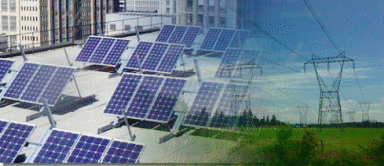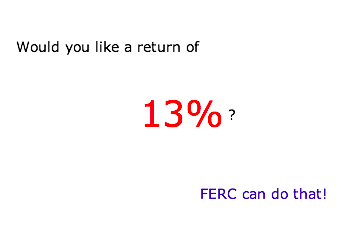 In the clean energy community, collaborative meetings often reveal a unity around goals (maximizing clean energy production and use) but a disagreement over the means. It’s not that people oppose distributed generation, but rather they see it as a secondary approach to meeting long-term clean energy goals. The following conversation is typical:
In the clean energy community, collaborative meetings often reveal a unity around goals (maximizing clean energy production and use) but a disagreement over the means. It’s not that people oppose distributed generation, but rather they see it as a secondary approach to meeting long-term clean energy goals. The following conversation is typical:
Advocate 1: Cheap wind from the Midwest and solar from the Southwest are constrained by the antiquated transmission system. We need a new, nationwide supergrid to move wind and solar from cheap places to where power is more expensive or where resources are limited!
Advocate 2: Yeah!
DG Guy: Actually, there’s a fair amount of evidence that most states have sufficient renewable resources to be self-sufficient, that the relative costs of local generation aren’t much higher (especially when factoring in local economic benefits), that distributed generation of wind and solar can use an abundance of spare capacity on existing distribution grid infrastructure, often at a much lower cost than high-voltage transmission, and can scale up more quickly than centralized generation that relies on new transmission infrastructure.
Advocate 1: Good points. We should build a supergrid and do distributed generation!
Advocate 2: Yeah!
In principle, it’s certainly acceptable to want to use every strategy to maximize clean energy production. In practice, financial resources are limited, the system of regulations and incentives are skewed toward centralized solutions, and choosing one strategy (long-distance transmission of centralized generation) necessarily reduces the money available and future prospects for expanded distributed generation.
For example, this dynamic is playing out at the Federal Energy Regulatory Commission (FERC), where the federal government is routinely providing utilities with bonuses to their return on equity for large-scale, high-voltage transmission projects. Since 2007, FERC has had 45 requests for bonus incentives for transmission development – authorized under the 2005 Energy Policy Act – and has provided all or most of the  requested incentives in more than 80 percent of the cases. With the bonuses, the average return on equity for utilities for their new transmission investments is nearly 13 percent. This high rate of return is a full 2.5 percentage points higher than the median utility return on equity, a value considered just and reasonable by state public service commissions in ordinary times. However, these rewards came during a time when unemployment doubled, the stock market tumbled, and most corporations were lucky to have any profit.
requested incentives in more than 80 percent of the cases. With the bonuses, the average return on equity for utilities for their new transmission investments is nearly 13 percent. This high rate of return is a full 2.5 percentage points higher than the median utility return on equity, a value considered just and reasonable by state public service commissions in ordinary times. However, these rewards came during a time when unemployment doubled, the stock market tumbled, and most corporations were lucky to have any profit.
The ratepayer impact of these bonuses is significant. In a November 2010 criticism of FERC transmission awards, Commissioner John Norris noted that the 2 percent bonus FERC provided to the PATH high-voltage project on the Eastern seaboard would “cost [Maryland] ratepayers in PJM at least $18 million per year.” The bonus payments were also given in concert with other incentives that reduced risk, including rate recovery during construction and guarantee of payment if the facilities were abandoned for reasons outside utility control.
While FERC asserts that it uses the bonuses to help incentivize the development of new transmission to improve reliability and reduce congestion, it doesn’t do its homework. Rather, FERC (1) refuses to study more economical alternatives, (2) doesn’t require the incentives to be necessary for the transmission development, (3) doesn’t even require that the proposed utility expenditures are prudent:
FERC: “There is no requirement in section 219 or Order No. 679 that an applicant must demonstrate that its project is the best of all possible projects, or that it has explored every conceivable alternative before deciding to proceed with a particular project.”
FERC: “we note that [American Electric Power] is under no obligation under either FPA section 205 or FPA section 219 to establish that the incentives requested are necessary.”
FERC: Moreover, the Commission generally does not require that utilities seeking to recover costs through their rates demonstrate initially that all expenditures for which they seek recovery were prudent.76 Rather, participants in rate proceedings seeking to challenge the expenditures must first create a serious doubt as to the prudence of the expenditures before the burden shifts to the filing utility.77 As stated in Order No. 679, “[t]he Commission is making no change in the long-standing regulatory presumption in a section 205 proceeding that costs are prudently incurred, but parties are free to provide evidence to the contrary . . . .” [emphasis added]
FERC also routinely hands out a 0.5% bonus incentive to every utility for participation in its respective regional transmission organization (RTO). This reward is given to every utility that asks for it, despite a Government Accountability Office report suggesting that the consumer benefits of such membership are unproven; and in one case, despite the fact that the requesting utility was already required by state law to participate in the RTO.
The most likely outcome of FERC’s lavish program for transmission development is a significant increase in utility shareholder profits at the expense of ratepayers, with only marginal improvements in the amount of available transmission capacity for new centralized renewable energy projects. The program may actually decrease utility interest in expanding transmission capacity, because offering them a higher ROE increases the total cost of new infrastructure, decreasing the demand for it and reducing investment.
When talking clean energy policy, it may sound inclusive to suggest that “we can do both” centralized and decentralized renewable energy development. But money for clean energy is zero-sum. The millions of dollars FERC is expending to boost utility shareholder profits for new transmission development cannot be deployed as new distributed generation. Instead, the focus on centralized generation infrastructure creates a path dependency that can limit opportunities for distributed generation development.
As we’ll discuss in a later post, the reverse is not true. A commitment to distributed generation may actually help (not harm) prospects for centralized generation.


